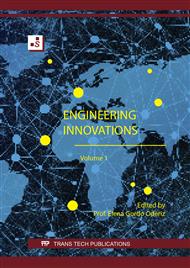[1]
Philippine Statistics Authority. 2016 Annual Survey of Philippine Business and Industry - Agriculture, Forestry and Fishing Sector With Total Employment of 20 and Over : Preliminary Results. Philippine Statistics Authority, 2018, psa.gov.ph/content/2016-annual-survey-philippine-business-and-industry-aspbi-agriculture-forestry-and-fishing.
Google Scholar
[2]
M. V. Lopez, T. C. Mendoza & E. R. Genio, Sustainable Agriculture in the Philippines, Journal of Sustainable Agriculture, 2008, 31:3, 111-131,.
DOI: 10.1300/j064v31n03_08
Google Scholar
[3]
Gerpacio, Roberta V. & Labios, Jocelyn D. & Labios, Romeo V. & Diangkinay, Emma I., Maize in the Philippines: Production Systems, Constraints, and Research Priorities, Maize Production Systems Papers 7650, CIMMYT: International Maize and Wheat Improvement Center, 2004, https://doi.org/10.22004/ag.econ.7650.
DOI: 10.58297/fwxl2434
Google Scholar
[4]
J. Bright, et al. Optimization of quadcopter frame using generative design and comparison with DJI F450 drone frame. IOP Conference Series: Materials Science and Engineering. 2010, doi: https://doi.org/10.1088/1757-899X/1012/1/012019.
DOI: 10.1088/1757-899x/1012/1/012019
Google Scholar
[5]
K. R. Krishna, Push button agriculture: Robotics, drones, satellite-guided soil and crop management. Apple Academic Press (2017).
DOI: 10.1201/b19940-4
Google Scholar
[6]
C.G. Ferro, B. Salvatore, R.Torre, and P. Maggiore, Characterization of ABS specimens produced via the 3D printing technology for drone structural components. Curved and Layered Structures 3, no. 1. (2016).
DOI: 10.1515/cls-2016-0014
Google Scholar
[7]
J.R.C. Dizon, A.H. Espera, Q. Chen, and R. Advincula, Mechanical Characterization of 3D-Printed Polymers, Additive Manufacturing, Volume 20, 2018, 44-67, ISSN 2214-8604, Doi: https://doi.org/10.1016/j.addma.2017.12.002.
DOI: 10.1016/j.addma.2017.12.002
Google Scholar
[8]
A. D. Valino, J. R. C. Dizon, A. H. Espera, Q. Chen, J. Messman, and R. C. Advincula, Advances in 3D printing of thermoplastic polymer composites and nanocomposites, Prog. Polym. Sci., vol. 98, 2019,.
DOI: 10.1016/j.progpolymsci.2019.101162
Google Scholar
[9]
A.H. Espera Jr., J.R.C. Dizon, C. Qiyi, and R.C. Advincula, 3D-printing and advanced manufacturing for electronics, Progress in Additive Manufacturing, volume 4, (2019), 245-267, doi: https://doi.org/10.1007/s40964-019-00077-7.
DOI: 10.1007/s40964-019-00077-7
Google Scholar
[10]
J. R. C. Dizon, A. D. Valino, L. R. Souza, A. H. Espera, Q. Chen, and R. C. Advincula, 3D Printed Injection Molds using various 3D Printing Technologies, Mater. Sci. Forum, vol. 1005, p.150–156, 2020, doi: https://doi.org/10.4028/www.scientific.net/MSF.1005.150.
DOI: 10.4028/www.scientific.net/msf.1005.150
Google Scholar
[11]
L. D. Tijing, J. R. C. Dizon, I. Ibrahim, A. R. N. Nisay, H. K. Shon, and R. C. Advincula, 3D printing for membrane separation, desalination and water treatment, Appl. Mater. Today, vol. 18, 2020,.
DOI: 10.1016/j.apmt.2019.100486
Google Scholar
[12]
G. G. C. J. L.D. Tijing, J. R. C. Dizon, 3D-Printed Absorbers for Solar-Driven Interfacial Water Evaporation: A Mini-Review, Submitt. to Adv. Sustain. Sci. Eng. Technol.
DOI: 10.26877/asset.v3i1.8367
Google Scholar
[13]
R. N. R. C. Advincula, J. R. C. Dizon, Q. Chen, I. Niu, J. Chung, L. Kilpatrick, Additive manufacturing for COVID-19: devices, materials, prospects, and challenges, MRS Commun., vol. 10, no. 3, p.413–427, (2020).
DOI: 10.1557/mrc.2020.57
Google Scholar
[14]
J.R.C. Dizon, D.W. Martinez, J.R. Diego, and G.S. Robles, Development of Smartphone-Controlled Hand and Arm Exoskeleton for Persons with Disability, Open Engineering, vol.11, no.1, 2021, pp.161-170, doi: https://doi.org/10.1515/eng-2021-0016.
DOI: 10.1515/eng-2021-0016
Google Scholar
[15]
A.C. Mckinnon, The possible impact of 3D printing and drones on last-mile logistics: An exploratory study. Built Environment 42, no. 4 (2016), 617-629.
DOI: 10.2148/benv.42.4.617
Google Scholar
[16]
A.C. Rola, S.B. Jamias, and J.B. Quizon, Do farmer field school graduates retain and share what they learn? An investigation in Iloilo, Philippines. In Farmer field schools: Emerging issues and challenges. International Learning Workshop on Farmer Field Schools. (2002), p.261.
DOI: 10.5191/jiaee.2002.09108
Google Scholar
[17]
J. Shukla, C. Nobre, and P. Sellers, Amazon deforestation and climate change. Science 247, no. 4948 (1990), 1322-1325.
DOI: 10.1126/science.247.4948.1322
Google Scholar
[18]
P.J. Bristeau, C. François, D.Vissiere, and N. Petit, The navigation and control technology inside the AR drone micro UAV. IFAC Proceedings Volumes 44, no. 1 (2011), 1477-1484.
DOI: 10.3182/20110828-6-it-1002.02327
Google Scholar
[19]
K. Szykiedans, & W. Credo, Mechanical properties of FDM and SLA low-cost 3-D prints. Procedia Engineering 136 (2016), 257-262.
DOI: 10.1016/j.proeng.2016.01.207
Google Scholar
[20]
P. Pecho, et al., Introduction Study of Design and Layout of UAVs 3D-printed Wings in Relation to Optimal Lightweight and Load Distribution. Transportation Research Procedia, vol. 40, 2019, p.861–68. Crossref,.
DOI: 10.1016/j.trpro.2019.07.121
Google Scholar
[21]
J.R.C. Dizon, D.W. Martinez, J.R. Diego, and G.S. Robles, Development of Smartphone-Controlled Hand and Arm Exoskeleton for Persons with Disability, Open Engineering, vol.11, no.1, 2021, pp.161-170, doi: https://doi.org/10.1515/eng-2021-0016.
DOI: 10.1515/eng-2021-0016
Google Scholar
[22]
A.M. Jubair, S. Hossain, M.D. Al Masud, K.M. Hasan, S.H. Newaz, and S.M. Ahsan, Design and development of an autonomous agricultural drone for sowing seeds. 7th Brunei International Conference on Engineering and Technology Journal (2018), 101-4.
DOI: 10.1049/cp.2018.1598
Google Scholar


